| HPGRS HISTORY |

|
Chronological History of the Cheyenne Horticultural Field Station/High Plains Grasslands Research Station (1928-2008)
|
Authorized by Congress on March 19, 1928; The Station was established with the purpose of experimenting with and propagating shade, ornamental, fruit and shelterbelt trees, shrubs, vines and vegetables adapted to the local conditions. The Station was 2139 acres with 199 year lease from the City of Cheyenne. Originally named Central Great Plains Field Station; Station was to complement Northern Great Plains Field Station (Mandan, North Dakota) and Southern Great Plains Field Station (Woodward, Oklahoma) Temporary office prior to construction of buildings. |
 |
|
June 1928 - Building construction began under the direction of Robert Wilson, the Station's first superintendent (1928 to 1930). Men carrying a wall for the root cellar, it took a lot of men to build the buildings and finish the grounds around the buildings. Many of the men were local residents; along with men from the Conservation Civilian Corp Camp located on the same property. |
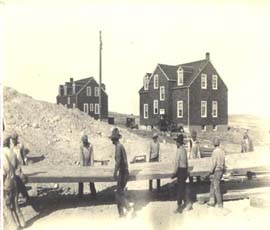 |
|
1929 - The first buildings were mostly completed and several new ones started. Then the work on the roads and grounds started. Along with the windbreak plantings on the station property and on various farms in the area. With all the workers at the station at this time they hired a cook for the messhall; 6,811 meals were served from May 1 to December 31. It cost $1.00 for 3 meals a day for the workers. They added a dairy room on the barn and purchased some Guernsey cows. |
 |
|
1930 - Name change to Cheyenne Horticultural Field Station and A.C. Hildreth (1930-1959) was named superintendent. Dr. Hildreth worked at the Cheyenne station from 1930 until World War II , he helped develop a collection of over 20,000 Horticultural species and varieties for testing their adaptability to the cold, dry, short growing seasons in the Rocky Mountains and Great Plains Regions. Research of importance was the research and selection of hardy shrub, tree and grass varieties that were used in the shelterbelt system for farms in the dust bowl states during the mid 1930's. Hildreth took different assignments in various locations throughout his tenure at the Cheyenne research station. He retired from the government in 1959 and moved from Cheyenne to Denver, to become the director of the Denver Botanical Gardens. |
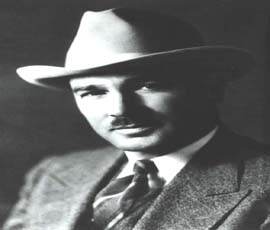 |
|
1930 - research began first plantings of trees, shrubs, fruits and vegetables were done at the station. There were many vegetables grown; onions, asparagus, tomatoes, squash and pumpkins. The first mini pumpkins were developed here. Numerous flowers were also started and tested at the reseach station. Many annuals such as petunias, marigolds, snapdragons, and ten-week-stocks were the most promising of several tried. Snapdragons and ten-week-stoks were very frost resistant. The perenials were started, several hundred pounds of tulips and narcissus bulbs from Bellingham Bulb station were donated and planted at the station. |
 |
|
1930 - Numerous shelterbelt and landscape plantings made on cooperator lands, including 333 private farms in Wyoming, Colorado, Nebraska, Kansas, Utah and South Dakota. The scientist started many tree nurseries of forest seedlings that they had gathered. They applied a sulpghinated oil to the seedlings to prevent rabbit injury. Trees were also tested to see if they could survive in the soil of the Great Plains. 25 acres in front of the buildings was planted in ornamental trees, includingChinese and American elm, honey locust, Douglas fur, Russian olive, native cedar, mountain ash, hackberry, native aspen, bur oak, Gambelle oak, hawthorn and native mountain maple, the last six raely used in this region. All did very well. |
 |
|
1932- building construction ended in the early thirties. The curbs along the front roadway in the building area was put in. The cattle gaurd was put in at the front gate. The property was completely enclosed by stock-tight fence and cattle gaurds at all public entrances. Weather was unfavorable for many of the plants this year because of a temperature of 20 degrees on May 20th frozen many trees and killed thousands of strawberry plants which had just been set out. 1933 - First scientific publication. Emerson, J.L. and A.C. Hildreth. 1933. Preliminary report on reducing transpiration of transplanted evergreens. Science 77:433-434. |
 |
|
1935 - Many inprovements were made to the station; the main road was oiled from the entrance to the buildings. Civilian Conservation Corp camp of 200 men opened on station. They constructed roads, 2 miles of concrete lined ditches, irrigation system, planted thousands of trees and shrubs. They picked up hundreds of tons of stones from the experimental plots. And manure collected from nearby ranches was hauled in and spread over a 100 acres.
|
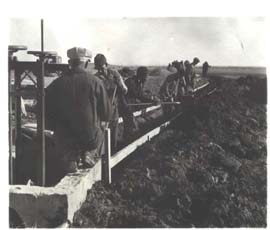 |
|
In 1935 there were 6810 fruit trees living on the research station. 1300 varieties of fruit trees tested (apples, pears, plums, cherries) and 300 varieties of small fruits (raspberries, currants, gooseberries, strawberries) Fruit variety testing is also carried on coperatively at Sheridanm Afton, Torrington, Lyman, Lusk, Gurnsey, Evanstan, Evers, Bear Creek and Keeline, Wyoing: Alliance and Ellsworthe , Neberaska; Newell, South Dakota and at Hays and McDonald, Kansas.
|
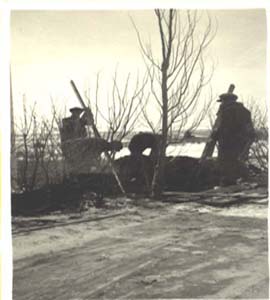 |
|
In the beginnging Strawberries and Raspberries did not like the cold dry windy Wyoming winters. They had to be covered to proctect them from the elements. In 1933 Cooperative fruit test plantings were made in Sheridan, WY . One planting was at the State Girl's Industrial Home, this planting included apples, plums, cherries, currants, gooseberries and raspberries. This project was highly successful and encouraged several other state institutions to attempt some fruit production, 42,000 native strawberry collections from Montana to New Mexico. Led to release of superior varieties (Radiance, Ogallala and Fort Laramie)
|
 |
|
1936 - The work of the Division of Forage Crops and Diseases was initiated at the Cheyenne Horticultural Field Station with the appoinment of H.M. Benedict as Agent. The ultimate nature of the work to be carried on was to be the study of physiology of the range grasses in relation to the behavior of the grasses under different conditions of environment or reage management. 200 species of grass and forages were studied at the station. Two of the first to be studied were Agropyron smithii and Bouteloua gracilis.
|
 |
|
The photo shows the station in 1940 and many of the trees that were planted around the buildings. |
 |
|
1942 - (WWII) - Hildreth and other scientists temporarily reassigned to California to study guayule (a rubber-producing shrub (Parthenium argentatum) of the southwest U.S. and Mexico.) Photo: Chicory crop; Chicory was important during the war because it was used as a replacement for coffee. |
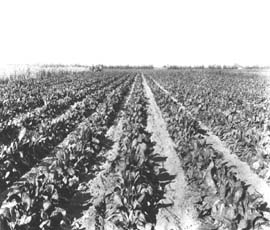 |
|
1946 to 1955 - Hildreth become the Superintendent for the USDA research stations at Mandan, North Dakota and Woodward, Oklahoma, in addition to the Cheyenne station. 1955-1957 - Hildreth leads Afghanistan effort to establish that country's agricultural experiment station Photo of Flowers and ornamentals |
 |
|
1961 - potato research initiated with University of Wyoming and USDA station at Greeley, Colorado 1962 - published 28 years of fruit tree tests - 1,200 apples, 300 plums, 50 cherries, 40 pears |
 |
| 1964 - Gene Howard became superintendent - started chrysanthemum and carnation research 1970 - Cheyenne Hardy Mums were named official Cheyenne flower |
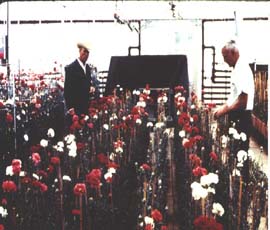 |
| 1974 - Horticultural work and shelterbelt work terminated. Began rangeland, mined-land reclamation and water conservation research focus | 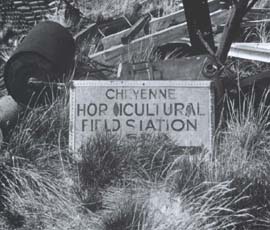 |
|
1974 - name change for station - High Plains Grasslands Research Station |
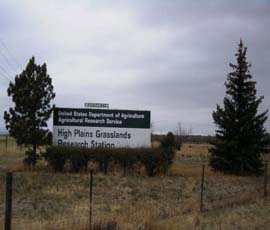 |
| 1980 - Additional 730 acres added to Station from FE Warren Air Force base. Initiated stocking rate X grazing system research in 1982. | 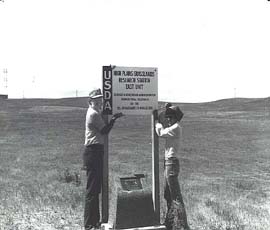 |
|
1981 - Jerry Schuman became Research Leader of the Station Mid 1980s - research addressed soils on marginal croplands (i.e., CRP lands) |
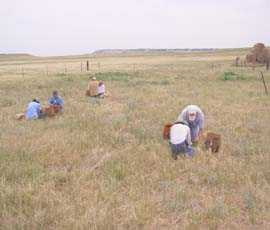 |
| Mined-land research a. seedbed ecology, cold tolerance, moisture uptake b. planting recommendations c. topsoil depth replacement d. sagebrush establishment e. industry bond release requirements |
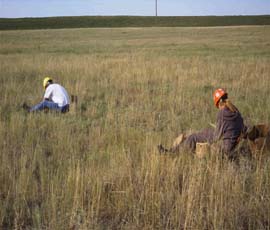 |
| Grazing studies a. season-long vs. time-controlled vs. rotationally deferred b. stocking rates c. economics of stocking rates and modeling programs (STEERISK, SMART) d. cattle gains e. vegetation composition changes f. sustainable grazing practices |
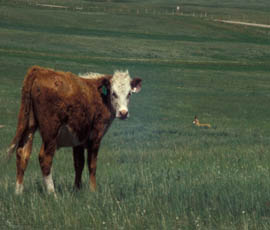 |
| 1991 - High Plains Grasslands Research Station became headquarters for ARS range research programs in Wyoming and Colorado (includes the 15,500 acre Central Plains Experimental Range research station near Nunn, and the Crops Research Laboratory in Fort Collins) Combine they are the Rangelands Resources Research Unit. | 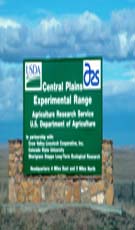 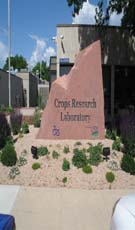 |
| 1998 - Jack Morgan became Research Leader Environmental aspects of grazing practices; Carbon sequestration and Global change |
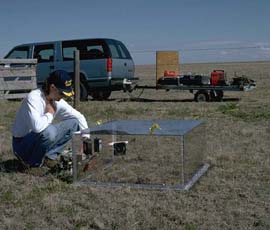 |
| Rangeland Monitoring 2000 - Cooperative efforts with BLM initiated with aerial photography |
 |
|
2002 - Justin Derner and Dana Blumenthal added to scientific staff 2009 - Justin Derner became Research Leader. |
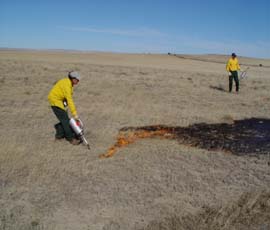 |
|
2007 - 138 acres of land transferred back to City of Cheyenne for development of High Plains Arboretum and Roundtop Park Photo of station 2000. |
 |
